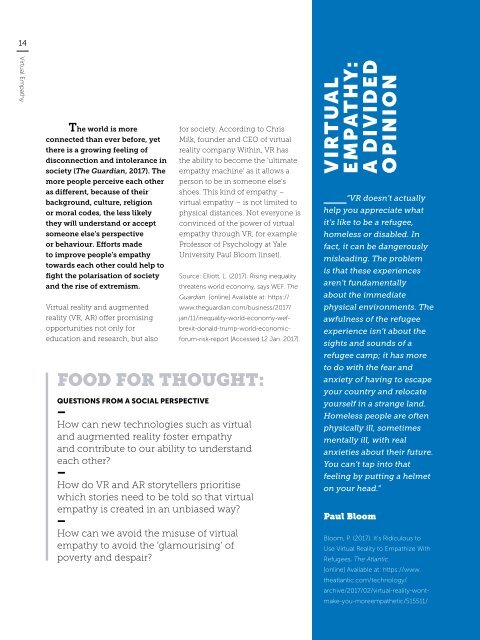trend-report-dps-web-version
Create successful ePaper yourself
Turn your PDF publications into a flip-book with our unique Google optimized e-Paper software.
14<br />
15<br />
Virtual Empathy<br />
The world is more<br />
connected than ever before, yet<br />
there is a growing feeling of<br />
disconnection and intolerance in<br />
society (The Guardian, 2017). The<br />
more people perceive each other<br />
as different, because of their<br />
background, culture, religion<br />
or moral codes, the less likely<br />
they will understand or accept<br />
someone else’s perspective<br />
or behaviour. Efforts made<br />
to improve people’s empathy<br />
towards each other could help to<br />
fight the polarisation of society<br />
and the rise of extremism.<br />
Virtual reality and augmented<br />
reality (VR, AR) offer promising<br />
opportunities not only for<br />
education and research, but also<br />
for society. According to Chris<br />
Milk, founder and CEO of virtual<br />
reality company Within, VR has<br />
the ability to become the ‘ultimate<br />
empathy machine’ as it allows a<br />
person to be in someone else’s<br />
shoes. This kind of empathy –<br />
virtual empathy – is not limited to<br />
physical distances. Not everyone is<br />
convinced of the power of virtual<br />
empathy through VR, for example<br />
Professor of Psychology at Yale<br />
University Paul Bloom (inset).<br />
Bloom, P. (2017). It’s Ridiculous to<br />
Use Virtual Reality to Empathize With<br />
Refugees. The Atlantic.<br />
[online] Available at: https://www.<br />
theatlantic.com/technology/<br />
archive/2017/02/virtual-reality-wontmake-you-moreempathetic/515511/<br />
Source: Elliott, L. (2017). Rising inequality<br />
threatens world economy, says WEF. The<br />
Guardian. [online] Available at: https://<br />
www.theguardian.com/business/2017/<br />
jan/11/inequality-world-economy-wefbrexit-donald-trump-world-economicforum-risk-<strong>report</strong><br />
[Accessed 12 Jan. 2017].<br />
FOOD FOR THOUGHT:<br />
QUESTIONS FROM A SOCIAL PERSPECTIVE<br />
–<br />
How can new technologies such as virtual<br />
and augmented reality foster empathy<br />
and contribute to our ability to understand<br />
each other?<br />
–<br />
How do VR and AR storytellers prioritise<br />
which stories need to be told so that virtual<br />
empathy is created in an unbiased way?<br />
–<br />
How can we avoid the misuse of virtual<br />
empathy to avoid the ‘glamourising’ of<br />
poverty and despair?<br />
VIRTUAL<br />
EMPATHY:<br />
A DIVIDED<br />
OPINION<br />
“VR doesn’t actually<br />
help you appreciate what<br />
it’s like to be a refugee,<br />
homeless or disabled. In<br />
fact, it can be dangerously<br />
misleading. The problem<br />
is that these experiences<br />
aren’t fundamentally<br />
about the immediate<br />
physical environments. The<br />
awfulness of the refugee<br />
experience isn’t about the<br />
sights and sounds of a<br />
refugee camp; it has more<br />
to do with the fear and<br />
anxiety of having to escape<br />
your country and relocate<br />
yourself in a strange land.<br />
Homeless people are often<br />
physically ill, sometimes<br />
mentally ill, with real<br />
anxieties about their future.<br />
You can’t tap into that<br />
feeling by putting a helmet<br />
on your head.”<br />
Paul Bloom<br />
• Virtual reality<br />
100<br />
75<br />
50<br />
25<br />
• Augmented reality<br />
Google graph showing interest in virtual and augmented reality over time (recreated)<br />
Numbers represent Google search interest relative to the highest point on the chart<br />
(peak = 100) over the last five years, worldwide.<br />
Sources: Google Trends. (2017) Search terms: virtual reality and augmented reality. [online] Available at:<br />
https://<strong>trend</strong>s.google.com [Accessed on 8 Mar. 2017].<br />
NEW TECHNOLOGIES<br />
The rise of virtual<br />
and augmented reality<br />
VIRTUAL REALITY (VR)<br />
is becoming an increasingly popular technology<br />
in the entertainment, education, humanitarian and<br />
healthcare sectors. By wearing a VR headset, users<br />
are fully surrounded by a virtual, mixed or 360º video<br />
environment and immersed in a new world. As VR<br />
goggles track the movement of the user, they can<br />
look around and in some cases, interact with their<br />
perceived environment.<br />
Recent tools for VR that have entered the market,<br />
showing that big players are taking this <strong>trend</strong> seriously,<br />
are Microsoft HoloLens, Oculus Rift (Facebook) and The<br />
Vive (Valve). Meanwhile, low-budget Google Cardboard<br />
has made VR more accessible to the wider public.<br />
2013 2015 2016<br />
AUGMENTED REALITY (AR)<br />
<strong>trend</strong>ed briefly in 2012, but interest in this technology,<br />
which combines the real world with the virtual, spiked<br />
in 2016, when the technology became more advanced.<br />
As with VR, AR requires the user to wear a headset in<br />
the form of see-through glasses (such as Microsoft<br />
HoloLens). While the real world is visible, reality is<br />
enriched with computer-generated information to<br />
create a unique and optimised experience.<br />
Examples of AR are enhanced tours on archaeological<br />
sites, in which the original buildings are projected on<br />
the places where only ruins are left, or the popular<br />
Pokémon Go game that became a worldwide craze in<br />
2016.<br />
Virtual Empathy





